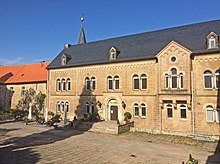Ilsenburg Castle
The ilsenburg house in the town of Ilsenburg (Harz) in Saxony-Anhalt received its present appearance in the second half of the 19th century. The building complex was built after 1860 on the west and north sides of the Romanesque complex of the Ilsenburg monastery . The building, built in the neo-Romanesque style, was owned by the Princes of Stolberg-Wernigerode until 1945 . The Ilsenburg Monastery Foundation has owned the castle since 2005 . Taking into account the still preserved medieval cloister building, an art and culture center with overnight accommodation for guests and a public restaurant is to be built here in the coming years.
history

The Benedictine monastery in Ilsenburg was dissolved in the course of the 16th century. The Counts of Stolberg took over the monastery complex including all possessions. They have exercised patronage over the monastery since the Count of Wernigerode died out in 1429. The Brandenburg Elector Friedrich Wilhelm I recognized the secularized monastery property as his property in 1687. During the Thirty Years' War , Wernigerode Castle, where Count Henrich Ernst lived, was so badly damaged that in September 1648 he moved his court to Ilsenburg. He moved into the widow's residence built between 1609 and 1615 by his cousin Heinrich for his wife Adriane on the west side of the former monastery grounds. For the next six decades, Henrich Ernst and his son Ernst ruled their county from the “Countess Stolberg House of Ilsenburg”, as the family still called the small property at that time. In 1700, Count Ernst arranged for the former monastery church to be redesigned. The high altar, the pulpit and the baptismal angel are works of lavish Baroque carving and still testify to the sculptural skills of their masters. In 1710 the Counts of Stolberg-Wernigerode moved the seat of government back to Wernigerode. The remaining cloister buildings were used for economic purposes in the following decades, and counts officials moved into the surrounding buildings. Between 1861 and 1863, Count Otto zu Stolberg-Wernigerode had the buildings above the Ilse converted into a residence for his uncle Botho. The Romanesque style of the monastery complex was deliberately taken up again here. The construction work was headed by Karl Frühling, to whom Count Otto then entrusted the renovation of his castle in Wernigerode. From 1897 on, Ilsenburg was the widow's seat of Princess Anna zu Stolberg-Wernigerode and her daughter Elisabeth. In 1929 Prince Christian Ernst leased the palace, the remains of the former enclosure and the adjacent park to the Old Prussian Union of Evangelical Churches in Berlin for 30 years. After some renovation work, the church seminar abroad began here in January 1930 to train theologians for service abroad. However, since the seminary submitted to the Confessing Church , it was dissolved in 1936. In the same year, the old Prussian Evangelical High Church Council set up a rest home for church employees in some rooms. Two years later a Protestant seminary was added. During the Second World War , the castle also temporarily housed a reserve hospital and a resettlement camp. It was looted shortly before the end of the war in May 1945. A few months later the Stolberg-Wernigerode family was expropriated. The community of Ilsenburg, as the new owner, signed a usufruct agreement with the Old Prussian Union for 80 years. In addition to a pastoral college and a singing academy, it also housed the Protestant Research Academy founded here in 1948 in the following years . With the establishment of the exclusion zone in 1961, church work had to be stopped. Until 1972, the Ministry of State Security owned the entire property. From 1974 to 1990 the castle building housed a rest home for employees of the Ministry of Agriculture and Food. It was continued as a hotel until it was acquired by the Ilsenburg Monastery Foundation in 2005.
literature
- Ferdinand Schlingensiepen (ed.): Theological study in the Third Reich. The church seminar abroad in Ilsenburg / Harz. Düsseldorf 1988. ISBN 3-930250-25-X .
- Gottfried Maron: A thousand years of Ilsenburg as reflected in the history of the monastery and castle . Darmstadt 1995, ISBN 3-920606-15-9 .
- City of Ilsenburg (ed.): 995-1995. 1000 years of Ilsenburg / Harz. Ilsenburg / Wernigerode 1995.
- Claudia Grahmann: From the Count's House to Ilsenburg Castle. In: Neue Wernigeröder Zeitung 16/2003.
Web links
- Material on Ilsenburg Castle in the Duncker Collection of the Central and State Library Berlin (PDF; 298 kB)
- Illustration by Heinrich Wilhelm Teichgräber from 1842 ( digitized version )
Coordinates: 51 ° 51 ′ 35 " N , 10 ° 40 ′ 43" E


